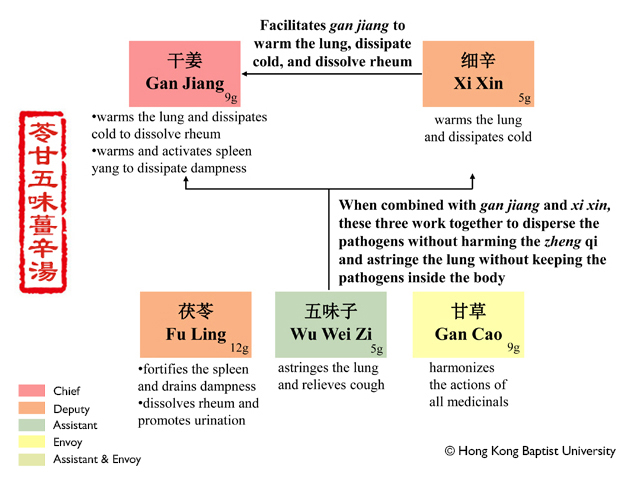 【First page】 >
【Tour】 >
【Poria, Licorice Root, Schisandra, Dried Ginger, and Asarum Decoction】
【First page】 >
【Tour】 >
【Poria, Licorice Root, Schisandra, Dried Ginger, and Asarum Decoction】
|
|
 Chinese Medicinal Material Chinese Medicinal Material
|
| 【Chinese Name】 |
苓甘五味薑辛湯
|
| 【Phonetic】 |
LIng Gan Wu Wei Jiang Xin Tang
|
| 【English Name】 |
Poria, Licorice Root, Schisandra, Dried Ginger, and Asarum Decoction |
| 【Classification】 |
Phlegm-expelling formulas |
| 【Source】 |
《Essentials from the Golden Cabinet》Jin Gui Yao Lue《金匱要略》 |
| 【Combination】 |
Poria (Fu Ling) 4 liang (12g), Glycyrrhizae Radix et Rhizoma (Gan Cao) 3 liang (9g), Zingiberis Rhizoma (Gan Jiang) 3 liang (9g), Asari Radix et Rhizoma (Xi Xin) 3 liang (9g), Schisandrae Chinensis Fructus (Wu Wei Zi) 0.5 liang (5g) |
| 【Method】 |
Decoct with water and take while it is warm. |
| 【Action】 |
Warms the lung and dissolves rheum. |
| 【Indication】 |
Ling Gan Wu Wei Jiang Xin Tang is indicated for coughing caused by a pattern of cold fluid-retention marked by coughing with a large amount of thin white sputum, a preference to spit out saliva, drooling, and a stuffy chest. The tongue coating is white and glossy and the pulse is wiry and slippery. |
| 【Pathogenesis】 |
This pattern is caused by spleen yang deficiency that generates internal cold and fluid retention. Deficient yang fails to transform dampness and as a result, pathogenic fluid retention forms. When it attacks the lung, the patient will cough. This is as the《Spiritual Pivot》Pathogens (Ling Shu - Xie Qi Zang Fu Bing Xing) described “the lung will be injured by (external or internal) cold and cold rheum accumulation". Cold fluid retention accumulates in the lung and prevents the lung from performing its normal function. The result is cough with a large amount of thin, white sputum. Fluid retention blocks qi movement, leading to chest stuffiness. Pathogenic rheum invades the stomach which causes one to want to spit out rheum. The treatment is to warm yang and dissolve fluid retention. |
| 【Application】 |
1. Essential pattern differentiation
Ling Gan Wu Wei Jiang Xin Tang is a commonly used representative formula for cough caused by cold rheum pattern. This clinical pattern is marked by cough with a large amount of thin, white sputum, glossy, white tongue coating, wiry and slippery pulse.
2. Modern applications
This formula may be used in the following biomedically defined disorders when the patient shows signs of interior cold fluid-retention: chronic bronchitis and emphysema.
3. Cautions and contraindications
It is not applicable to patients with patterns such as heat and dryness in the lung, cough caused by yin deficiency, and blood-tinged sputum. |
|
|

|




